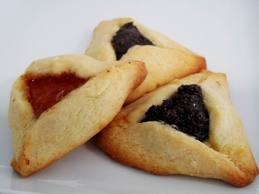
 |
[Updated: 2024.02.27] ![]()
 350x310.png) |
פּוּרִים, Hebrew plural from Akkadian-Babylonian ![]() ,
,![]() is the celebration of the deliverance of the Jews of ancient Iran (Persia) from the villain Hã•mãnꞋ (not "HEY-men"), related in the book of Es•teirꞋ (actually Ha•dasꞋãh; Hellenized to 'Esther').
is the celebration of the deliverance of the Jews of ancient Iran (Persia) from the villain Hã•mãnꞋ (not "HEY-men"), related in the book of Es•teirꞋ (actually Ha•dasꞋãh; Hellenized to 'Esther').
Scholars have long noted that the only similarities Pūr•imꞋ has are found in Babylonian and Persian (modern Iranian)—i.e. pagan—festivals, not like any Ta•na״khꞋ-based festival.
The most widely celebrated פּוּרִים festivity among Israeli Jews, also attracting the great majority who don't go to Beit ha-
 |
| Yael in Marge Simpson costume (Purim 2000; © 2000 Yirmeyahu Ben-David) |
The eve features the recitation of Mәgil•atꞋ Es•teirꞋ. The pã•rãsh•ãhꞋ is Shәm•otꞋ 17.8-16.
Today, Jews (only) offer a symbolic annual half-Shëqël before Minkhãh and the reading of the Mәgilãh at פּוּרִים. Outside of Israel, the local half-coin is offered (half-dollar, etc.) with the proceeds going to the poor.
During the recitation of Esteir, unlike other communities of Orthodox Jews, the Tei•mãn•imꞋ don't make noise after the name Hã•mãnꞋ. Also, the congregation repeats aloud, after the reader, the following pәsuqim after the reader: 2.5; 7.10; 8.15-16 & 10.3. (Reading a translation does not satisfy the mi•tzәw•ãhꞋ.)
The custom of מִשְׁלוֹחַ מָנוֹת has continued among Yәhud•imꞋ since Ës•teirꞋ 9.19,22. The Nәtzãr•imꞋ, and increasingly Orthodox rabbis, recommend providing מִשְׁלוֹחַ מָנוֹת to poor, hospitalized, shut-in and elderly Jews rather than swapping sweets with one's usual Jewish friends and neighbors.
 |
| אָזְנֵי הָמָן |
One of the most popular traditional פּוּרִים sweets is a triangular cookie with a poppy seed (or date, prune, etc.) filling. Probably, Hã•mãnꞋ had big ears because these cookies are called אָזְנֵי הָמָן. Assimilated European Jews Germanize this to "Hamantaschen," Yiddish (which we avoid along with any other assimilation) for "Haman's pockets."
Check with local senior homes, hospitals and the Jewish Community Center (JCC) for rarely-visited or unemployed Jewish residents and bring them a kã•sheirꞋ (or none at all!) מִשְׁלוֹחַ מָנוֹת. Work with the JCC.
All of the children, and many adults, come in costumes. In our Beit ha-KәnësꞋët, there's a party for the children immediately after the recitation of
Pay it forward (Quote & Cite):
| Yirmeyahu Ben-David. Purim (2024.02.27). Netzarim Jews Worldwide (Ra'anana, Israel). https://www.netzarim.co.il/ (Accessed: MM DD, YYYY). |
![]()
 |
 |